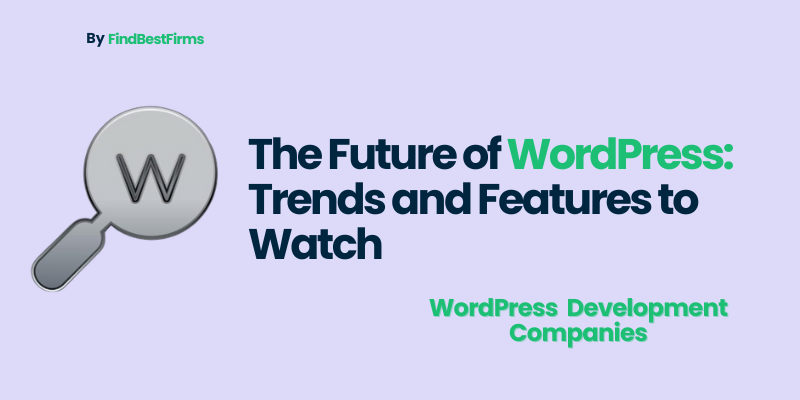WordPress has been the backbone of the internet for nearly two decades, powering over 43% of all websites globally. From personal blogs to enterprise-level e-commerce stores, it continues to evolve, offering flexibility, scalability, and a vast ecosystem of tools.
However, the platform is entering an exciting new chapter, one shaped by cutting-edge technology, changing user expectations, and the growing demand for performance and security.
For business owners, startups, and entrepreneurs, understanding where WordPress is heading can help you future-proof your digital presence and gain a competitive edge.
WordPressTrends and Features

1. Full Site Editing (FSE) Making the New Standard
The Full Site Editing is changing the manner in which users design and modify websites. You no longer have to toggle between WordPress customizer, widgets and theme settings to edit individual elements of your site, making it possible to edit your entire site in one place and in one interface. It implies that you can edit headers, footers, templates and even the page formats without any line of code.
In the case of startups and non-tech founders, this lessens the need to depend on developers to make minor changes to the product, but at the same time, it has creative control. It means more opportunities for developers to provide very customized designs within a shorter time. With an increasingly mature FSE, the WordPress themes will move to a block concept that will present the option to be as flexible as possible without losing performance.
2. Performance Optimization as a Priority Scheme
With site speed directly influencing conversions in a world where it is becoming a larger factor than ever before, WordPress is paying increasing attention to performance. By providing such features as lazy loading of images, support of webP, and continuous development of Core Web Vitals optimization, the platform is narrowing the gap with custom-coded websites.
WordPress Development Companies are also responding by incorporating lightweight themes, bare minimum setups of plugins as well as headless WordPress, to make sure load times are never in the slow lane. The SEO ranking of Google now greatly benefits the optimized websites, which is why future updates of WordPress are likely to prioritize performance in every release.
3. Artificial intelligence-based web content management and creation
Artificial Intelligence is fast infiltrating the WordPress ecosystem. Whether it is AI-powered SEO plugins such as Rank Math and Yoast content recommendations or a plugin that creates high-quality images or copy, WordPress is getting smarter. AI has now entered the picture capable of detecting broken links, auto-optimization of images, and even the improvement of site accessibility.
AI assistants can be a game changer to entrepreneurs who have to build their sites without having a full-time developer available; they can save time, improve quality and automate some recurrent tasks. You can also expect to see more profound integration of AI into the WordPress core and third party plugins to manage your site more efficiently than before.
4. Headless WordPress to be as Flexible as Possible
There is an increasing popularity of headless architecture where WordPress serves as a content management system (CMS) and the front end is developed using such modern frameworks as React or Vue. This enables more dynamic and faster websites that can be used to serve content anywhere, including mobile applications, IoT and so on.
Headless WordPress provides a content management system with the ideal balance between content control and contemporary user experiences to fast-scaling startups. Although it does take more complex development capabilities, now a large number of WordPress Development Companies are specialized in headless setups, providing bespoke solutions to high-aspiring brands.
5. Greater Emphasis on Security and Privacy
Cybersecurity threats are growing more sophisticated, and WordPress is addressing this head-on. Expect upcoming releases to feature stronger password management tools, advanced two-factor authentication, and improved default security configurations. GDPR compliance tools are also becoming more accessible for business owners targeting European markets.
For entrepreneurs and startups, these improvements mean you can focus on growth without constantly worrying about data breaches or compliance risks. Security plugins are also evolving, offering real-time monitoring and automatic malware removal.
6. Seamless E-Commerce Integration
WooCommerce, WordPress’s leading e-commerce plugin, is evolving alongside the core platform. Upcoming improvements in payment processing, AI-driven product recommendations, and frictionless checkout experiences will make it easier for small businesses to compete with big retailers.
In addition, third-party integrations with CRMs, inventory management tools, and marketing automation systems are becoming more plug-and-play. This is great news for startups aiming to scale quickly without investing heavily in custom e-commerce development.
7. Accessibility as a Non-Negotiable Attributes
Accessibility is no longer a luxury feature--it is a necessity. In upcoming WordPress releases, more attention is being paid to making websites inclusive so that they are accessible, and accessible out of the box to WCAG (Web Content Accessibility Guidelines).
Starting with better keyboard navigation and extending to more screen reader compatibility, these changes will not only be beneficial to users with disabilities, but also increase SEO rankings. Accessibility audits are also becoming a top priority among WordPress Development Companies as a way of enabling brands to gain more audiences.
8. No-Code and Low-Code Development on the Rise
No-code and low-code WordPress solutions are gaining popularity as more people become interested in fast and cheap solutions to websites. Themes based on blocks, drag and drop page builders and visual workflow plugins are enabling non-developers to create feature-rich websites.
Neither is this trend a substitute to professional development but rather an addition to it. Lots of companies begin using no-code and subsequently employ programmers to perfect and optimize their sites to perform faster and to strengthen branding.
9. The Expanding WordPress Plugins and SaaS Ecosystem
The open-source feature of WordPress enables endless innovation by the community of developers. The plugin marketplace is growing and is now including more SaaS integrations, including email marketing automation, analytics dashboards and more, delivering enterprise level functionality to small businesses at a fraction of the price.
It is possible to expect tighter integrations with cloud services, AI tools, and advanced analytics platforms that allow business owners to make data-driven decisions easily.
10. Sustainability and Eco-Friendly Web Hosting
As environmental awareness grows, website owners are seeking ways to reduce their digital carbon footprint. WordPress is seeing more eco-friendly hosting providers emerge, offering servers powered by renewable energy and optimized for minimal resource usage.
This trend aligns with the values of many modern startups and consumers, giving businesses a branding advantage while contributing to sustainability efforts.
The future of WordPress is exciting, filled with innovation that makes the platform faster, more secure, and more adaptable than ever. For business owners, startups, and entrepreneurs, staying ahead of these trends can help you leverage WordPress as a powerful growth engine.
Whether you’re planning your first site or upgrading an existing one, partnering with experienced professionals can ensure you fully capitalize on these advancements. The right WordPress Development Company can help you navigate emerging technologies, optimize performance, and create an online presence that’s ready for tomorrow’s opportunities.

